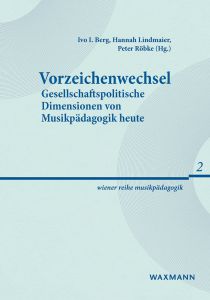Vorzeichenwechsel. Gesellschaftspolitische Dimensionen von Musikpädagogik heute, Ivo I. Berg, Hannah Lindmaier, Peter Röbke (eds.), Waxmann Verlag, 2019

How does the music education field deal with socio-political shifts, culturally relevant re-assessments of value, debates on norms, and new qualities? The volume Vorzeichenwechsel. Gesellschaftspolitische Dimensionen von Musikpädagogik heute [Key Changes. Socio-Political Dimensions of Music Education Today], edited by music educators Ivo I. Berg, Hannah Lindmaier, and Peter Röbke, is devoted to the premises of a modern approach—conceived of as a cultural and artistic practice—to teaching people to make music. The title says it all: by changing the chromatic signs in a given piece of music, one can “colour and shape” its development—albeit “based on a diatonic foundation that remains unchanged” (Berg/Lindmaier/Röbke: 7). The discursive key change effected in the 13 contributions here suggests critical perspectives and exhibits no reluctance to address uncomfortable questions and dissonances relating to approaches, participation, and exclusion. Borrowings from sociology and cultural studies (Reckwitz) and (migration-specific) educational research (Mecheril) determine this volume’s dialectical structure: its first section—entitled “Anstöße” [Impulses] (I)—and four “Diskursräume” [Spaces of Discourse] (II)—which include “Verorten” [Locating], “Öffnen” [Opening], “Handeln” [Acting], and “Bilden” [Educating]—deal with disparate aspects of and attitudes towards music education. The debate regards the extent to which concepts of diversity and inclusion must be set in relation to the diversity of music education-related efforts and their goals— and the matters to which this pertains include the “tension” between excellence and inclusion at the mdw (Röbke/Müller: 37). Discussion is also devoted to discriminating attributions (“transculturality as rootlessness”) in the context of music-making’s exploitation by right-wing populism (Röbke: 44). Ambivalences are revealed by a critical view of assumptions such as “music connects” and the rejection of “lines of differentiation” (Bradler: 102). And in cultivating learners (“identity work”), it is additionally necessary to shed light on the backdrop embodied by an “industrial society characterised by capitalism” as well as on the “balancing act” between individual needs and collective requirements (Ardila-Mantilla: 70/78). Who determines for what reason who is allowed to participate how in the canon of the arts? Question such as this one are raised and discussed repeatedly in this volume, resulting in possible answers that don’t necessarily promise to generate a consensus. And readers, for their part, are not released from their responsibility to reflect upon these key changes and put them into practice themselves. Doing so may seem arduous at first, but it is indeed the way forward.

